In the previous articles, adriaticnature tried to deal with the representatives of the following superorders inhabiting the Adriatic Sea: Elopomorpha, Stenopterygii, Scopelomorpha, Lampridiomorpha, Clupeomorpha, Cyclosquamata and Paracanthopterygii. All of them are included into the group of classes (superclass) called Osteichthyes. Another group of fish inhabiting the Adriatic belongs to the Chondrichthyes class, which includes sharks, rays and chimaeras. adriaticnature will get to them in the future.
The last and largest superorder, belonging to Osteichthyes and inhabiting the Adriatic, is the Acanthopterygii superorder. The representatives of this superorder are most often caught by fishermen searching for trophies on boats on the sea or on its rocky or sandy shores with spinning and float rods.
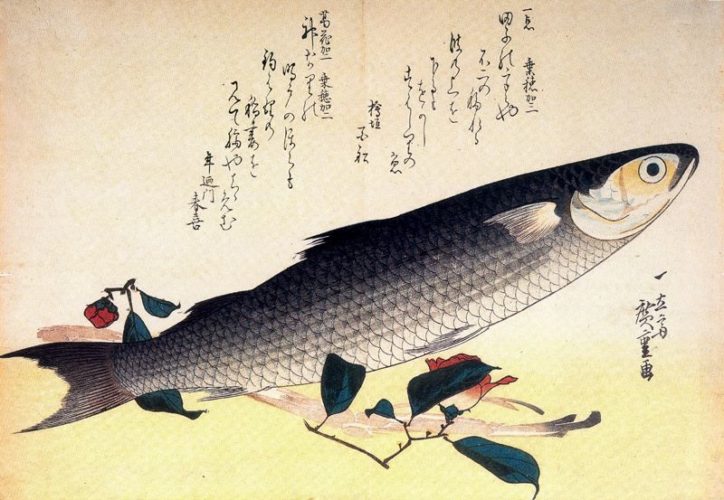
(“Mullet, asparagus and camellia”. Utagawa Hiroshige. 1832.)
Since there are quite a lot of orders and families in the Acanthopterygii superorder, adriaticnature will introduce fishes belonging to them to readers consistently, but in a free order. And let’s start with the description of the following two orders: Mugiliformes and Atheriniformes, so that there wouldn’t be too many short articles.
The Mugiliformes order comprises only one Mugilidae family, which, according to the latest scientific researches, includes 27 families and more than 80 species of fish. They are found in all inshore temperate and tropical sea waters of the world.
Mullets are mainly schooling fish feeding on detritus. Many of them are prone to jumps above the surface of the water. Scientists explain their behavior by the need for gulps of oxygen-rich air, of course, when it is not related to escaping from predators. Mullets have always been an important food source in Mediterranean Europe in the years since the Roman Empire.
Six species of mullet inhabit the Adriatic Sea:
Golden grey mullet (Chelon aurata).

(Golden grey mullet. Photo by © Pedro Niny Duarte(c)ImagDOP. fishbase.org)
The maximum recorded length is 59 cm; specimens up to 30 cm long are more common. It is a schooling fish. Adult individuals prefer to swim at the depths of more than 10 meters, entering the bays, estuaries and lagoons. Young fish often swim near the river mouths. It feeds on small benthic organisms, detritus, and sometimes insects and plankton. It is a permanent inhabitant of the Adriatic Sea.
Thicklip grey mullet (Chelon labrosus).
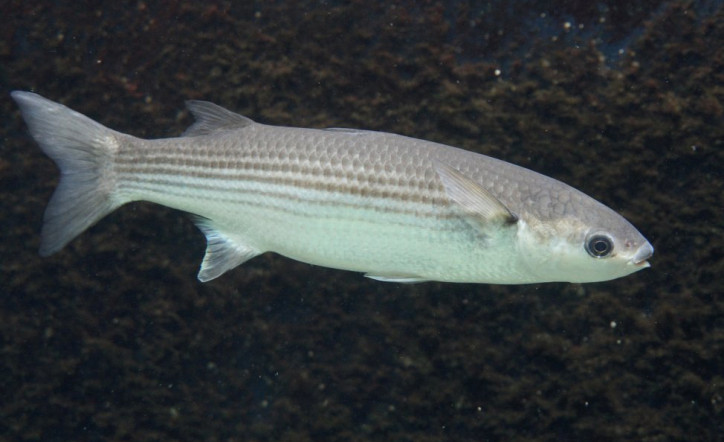
(Thicklip grey mullet. Photo by © Gilbert Angermann. tier-fotos.eu)
The maximum recorded length is 75 cm, specimens 32 cm long are more common. The maximum weight is 4.5 kilograms. This schooling coastal fish often enters brackish lagoons, likes fresh water. It feeds on algae and small invertebrates. It is a permanent inhabitant of the Adriatic Sea.
Thinlip grey mullet (Chelon ramada).
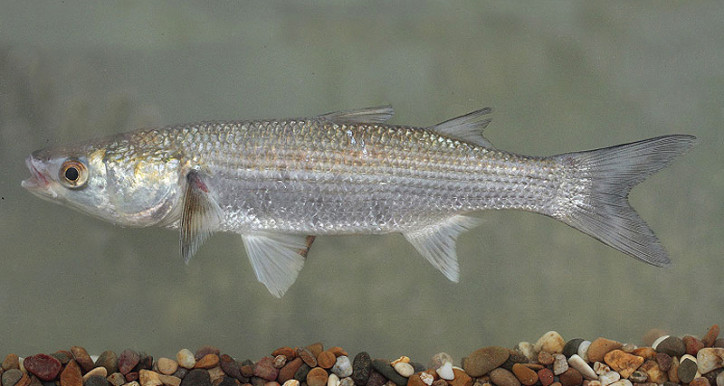
(Thinlip grey mullet. Photo © lomadelacebuchal.es)
The maximum recorded length is 70 cm; specimens up to 35 cm long are more common. The maximum weight is 2.9 kg. This schooling coastal fish often enters brackish lagoons, likes fresh water and swims upstream to the rivers. Adult individuals prefer to swim at the depths of more than 10 meters. It feeds on algae, detritus, small benthic and planktonic organisms. It is a permanent inhabitant of the Adriatic Sea.
Leaping mullet (Chelon saliens).
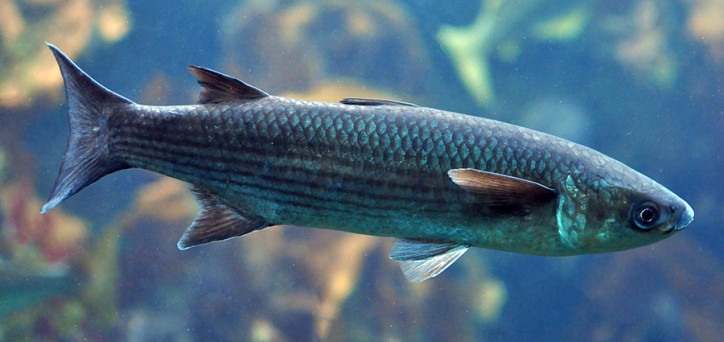
(Leaping mullet. Photo by © Citron. wikipedia.org)
The maximum recorded length is 40 cm; specimens up to 30 cm long are more common. This bottom schooling fish inhabits inshore waters, enters lagoons and estuaries. Adult individuals prefer to swim at the depths of more than 10 meters. It feeds on algae and detritus. It is a permanent inhabitant of the Adriatic Sea.
Flathead grey mullet (Mugil cephalus).

(Flathead grey mullet. Photo by © John E. Randall. fishbase.org)
It inhabits the depths up to 120 meters, usually up to 10 meters. The maximum recorded length is 100 cm; individuals up to 50 cm long are more common. It can weight up to 10, and possibly more, kilograms. This coastal schooling fish often inhabit river mouths and enters freshwater. It feeds on detritus, algae and microorganisms. It is a permanent inhabitant of the Adriatic Sea.
Boxlip mullet (Oedalechilus labeo).

(Boxlip mullet. Photo by © Roberto Pillon. fishbase.org)
The maximum recorded length is 25 cm. This coastal schooling fish often prefers to swim close to the river mouths, but doesn’t enter the fresh water. It feeds on detritus and algae. It is a permanent inhabitant of the Adriatic Sea.
Representatives of the Atheriniformes order, as well as representatives of the Mugiliformes order, are quite numerous and found in all tropical and subtropical waters of the World Ocean. Moreover, they inhabit freshwater bodies.
The closest relatives of Atheriniformes are representatives of the Cyprinodontiformes order, the most famous of which are guppies. Aquarists love them very much. Several species of Cyprinodontiformes inhabit the water bodies of the Adriatic coast. adriaticnature will deal with them in the section concerning freshwater inhabitants – Fishes of rivers and lakes. Guide.
Fish of the Atheriniformes order are usually of medium size. The largest representative of the Atherinopsis californiensis is 44 centimeters long. The order comprises more than 350 species.
Two species of silverside inhabit the Adriatic Sea. They are Atherina boyeri and Atherina hepsetus. The tastiness of these two small and similar fishes is highly appreciated by both predatory fish and admirers of Mediterranean cuisine.
Big-scale sand smelt (Atherina boyeri).
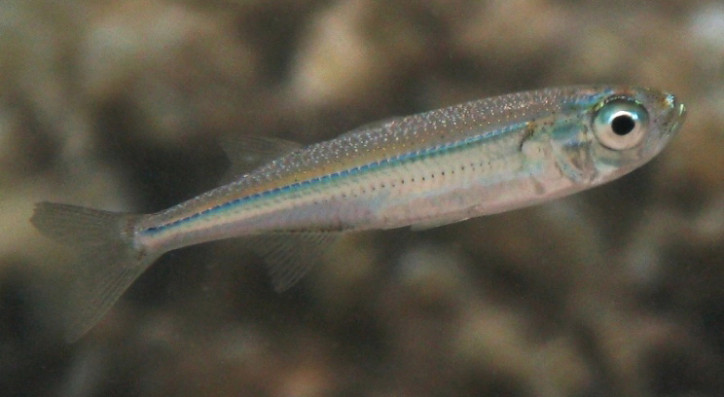
(Big-scale sand smelt. Photo by © Roberto Pillon. naturamediterraneo.com)
The maximum recorded length is 20 cm. This schooling species inhabits the coastal part of the sea near the mouths of the rivers, in their lower reaches. It can inhabit freshwater lakes, having a pelagic lifestyle. It feeds on small crustaceans, worms and mollusks. It is a permanent inhabitant of the Adriatic Sea. It was stocked and acclimatized in the freshwater lakes of Bracciano, Albano, Bolsena, Nemi and so on (Italy).
Mediterranean sand smelt (Atherina hepsetus).
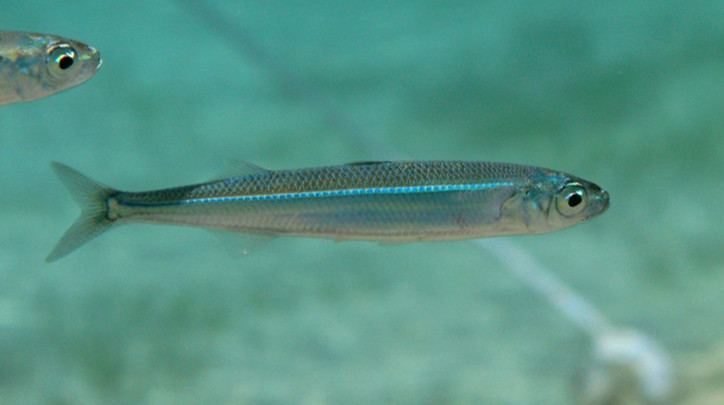
(Mediterranean sand smelt. Photo by © Roberto Pillon. fishbase.org)
The maximum recorded length is 20 cm; specimens up to 15 cm long are more common. It is a coastal sea schooling fish. Sometimes, it enters the bays, lagoons and parts of the rivers close to the mouth. It feeds on pelagic crustaceans and bottom crustaceans. It is a permanent inhabitant of the Adriatic Sea.